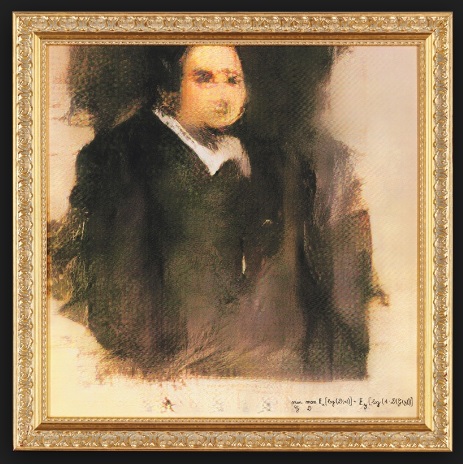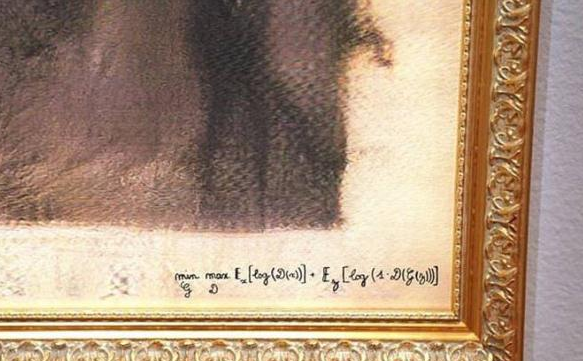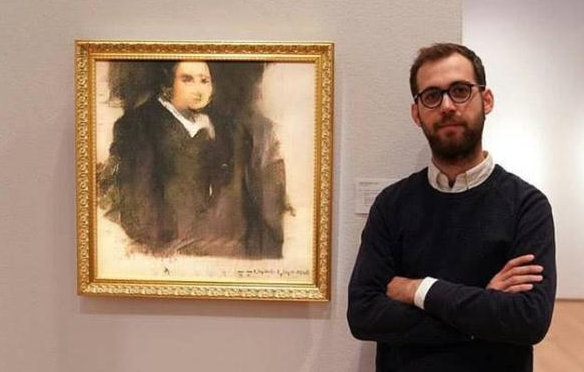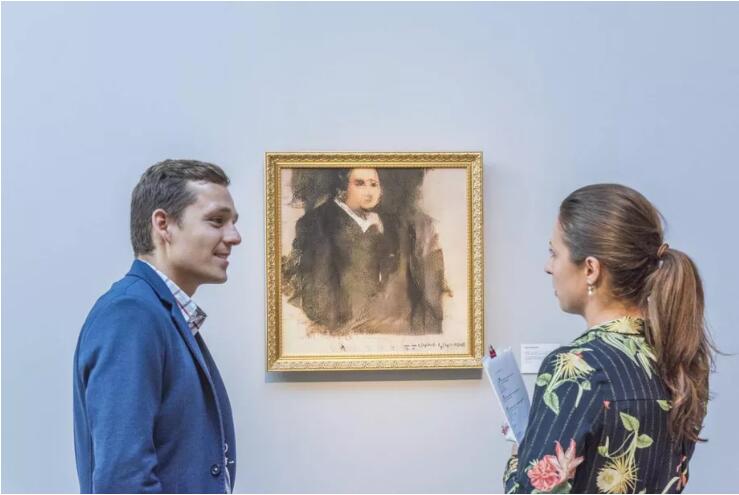这幅画卖出300万天价 但它的创作者却“不是人” Creepy AI-Created Portrait Fetches $432,500 at Auction
中国日报网 2018-10-26 13:35

佳士得最近举行了一场为期三天的拍卖会,拍品中有20多幅毕加索的画作,但有一幅画作拍出的价格比毕加索的这些画作都要高。这幅画作的创造者是“算法”,其43.25万美元的拍卖价在全场300多件拍品中名列第二。

Credit: Obvious
An unsettling portrait created by artificial intelligence (AI) made a historic appearance on the auction block at Christie's in New York City this week. It is the first artwork created by an algorithm to be offered for auction in the world of fine art.
本周,一幅具有颠覆意义的肖像画出现在纽约佳士得拍卖行的拍卖台上,此举颇有历史意义。这幅画作由人工智能创作,是艺术界首次拍卖由算法创作的艺术品。
The creepy-looking painting of a fictitious man in a dark frockcoat left the auction block at Christie's for a whopping $432,500 on Oct. 25 in New York City.
这幅画画的是一位身穿黑色双排扣长礼服的虚构人物,看上去有点诡异。10月25日,在纽约佳士得拍卖行拍出了43.25万美元(约合300万元人民币)的价格。
很多人可能觉得艺术品拍出这个价格很正常,但是看到画作的签名时估计你就不这样想了。这幅画的作者签名是一个数学方程式:min max Ex[log(D(x))] + Ez[log(1-D(G(z)))]。

The portrait — designed in the "Old Master" style reminiscent of European fine artists from centuries ago — only partially fills the canvas, leaving empty space around the central figure. It appears to represent a man with a blurred face, dressed in clothing similar to that worn by subjects painted by the Dutch artist Rembrandt van Rijn in the 17th century.
这幅画的颜料仅仅覆盖了部分画布,主体人像周围留出了大片空白。画作遵循数百年前的欧洲古典美术风格,似乎描绘了一名五官模糊的男子,其穿着的外衣类似于17世纪荷兰画家伦勃朗·梵·莱茵笔下人物的穿着。
当佳士得拍卖行决定拍卖这幅画时,团队成员都深感意外,但佳士得认为这次拍卖将标志着世界拍卖舞台上人工智能艺术的到来。
在拍卖之前,拍卖行给出的估价是1万美元。但是没想到,这幅画作遭到了疯抢。一位匿名的竞拍者进行了5次竞价,最终拿下了该画作。
Of course, a computer didn't spontaneously pick up a brush and become an artist. The AI that generated the image had human programmers — a Parisian art collective called Obvious, Christie's reported. Their collaboration, titled "Portrait of Edmond De Belamy," is part of a series of paintings of the fictional Belamy family and was expected to fetch $7,000 to $10,000, according to Christie's.
当然,计算机本身并不会自发地拿起画笔,变身艺术家。据佳士得介绍,创作这幅肖像画的人工智能依靠了人类程序员——一个名为“显而易见”的巴黎艺术团体。按照佳士得的说法,这幅画题为《埃德蒙·德-贝拉米像》,是虚构的贝拉米家族系列画作中的一件,原本估价7000至10000美元。
To generate the portrait, the Obvious team first fed the neural network a diet of 15,000 images painted between the 14th and 20th centuries, to train it to recognize visual elements in fine art, Obvious artist Hugo Caselles-Dupré told Christie's. The algorithm that eventually created an original image had two parts that worked against each other, called the Generator and the Discriminator; they dubbed this combative AI "generative adversarial network" (GAN), Caselles-Dupré explained.
“显而易见”团队的艺术家雨果·卡塞列斯-迪普雷告诉佳士得拍卖行,为生成这幅肖像画,他们首先将15000幅14至20世纪作品的图像输入一个神经网络,训练它辨认艺术品中的视觉元素。据介绍,最终生成原创画作的算法由两个相互矛盾的部分组成,分别被称作“‘生成者与“辨别者”。“显而易见”团队把这种斗争性人工智能称为“生成式对抗网络”。

"The Generator makes a new image based on the set, then the Discriminator tries to spot the difference between a human-made image and one created by the Generator. The aim is to fool the Discriminator into thinking that the new images are real-life portraits. Then, we have a result," he told Christie's.
卡塞列斯-迪普雷说:“‘生成者’依据作品库生成新图像,然后‘辨别者’会努力分辨人类画作与‘生成者’画作的区别。我们的目的是把‘辨别者’搞糊涂,让它以为新图像就是真人创作的肖像画。这时,我们的成果就产生了。”
GAN's final image was then inkjet-printed on canvas and framed, according to Obvious. At the bottom of the portrait is a mathematical formula representing the algorithm that created it, a nod to the relationship between the Generator and the Discriminator, Obvious artists wrote on the collective's website.
然后,“生成式对抗网络”创作出的成品会被喷墨打印机绘制在画布上,并装框成画。“显而易见”团队在其官方网站上介绍说,《埃德蒙·德-贝拉米像》的画面底端有一行数学公式,代表了生成这幅画的算法,肯定了“生成者”与“辨别者”之间的关系。
The goal of the painting and of Obvious, also co-founded by Hugo Caselles-Dupré and Gauthier Vernier, was to prove "artificial intelligence can do more than operate driverless cars or transform manufacturing — it can be creative," CNBC reported.
据美国全国广播公司财经频道报道,“显而易见”团体创作这幅画是为了证明“人工智能不仅能驾驶无人汽车,或者改变制造业,它还很有创造性。”这一团体由雨果·卡塞列斯-迪普雷和戈捷·维尔涅共同创立。

Portraiture is a tough genre for AI to take on, according to Christie's, "since humans are highly attuned to the curves and complexities of a face in a way that a machine cannot be."
佳士得拍卖行表示,对于人工智能来说,肖像画是非常难呈现的一个绘画体裁,“因为人们很擅长画脸部的曲线和复杂部位,而人工智能往往做不到。”
This difficulty was part of Obvious' thinking when they created the portrait.
“显而易见”团体创作这幅画时也考虑到了这个难点。
"We did some work with nudes and landscapes, and we also tried feeding the algorithm sets of works by famous painters. But we found that portraits provided the best way to illustrate our point, which is that algorithms are able to emulate creativity," Caselles-Dupré said.
卡塞列斯-迪普雷说:“我们还用人工智能创作了一些裸体画和风景画,还曾尝试把名画家的画作输入进去。但我们发现肖像画能最好地阐明人工智能画作的特点,也就是算法也可以模拟出人类的创造性。”
"Edmond de Belamy" is one of 11 AI paintings made by Obvious.
“显而易见”团体共创作了11幅人工智能画作,这是其中一幅。

来源:livescience、cnbc、参考消息网、光明网、量子位微信公众号
翻译&编辑:yaning

















 英语点津微信
英语点津微信 双语小程序
双语小程序